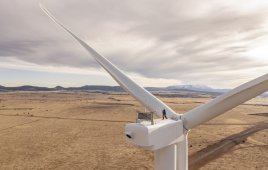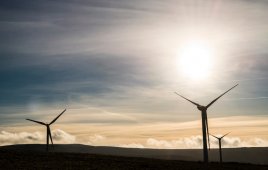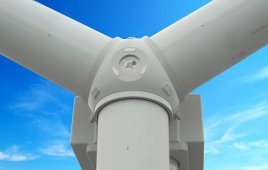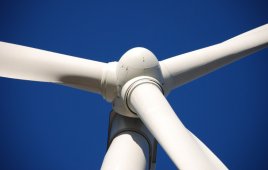
The Metalastik Spherilastik “teeter” bearing comes from Trelleborg Industrial AVS.
A few early wind turbines in the U.K. drew considerable criticism because they were noisy, So Wind Energy Group Ltd. (WEG) paid more attention to acoustic isolation in the recent MS-3 turbine. The primary noise-attenuation feature was a Metalastik Spherilastik “teeter” bearing from Trelleborg Industrial AVS. The bearing acts as a resilient spherical joint. In addition, the compact rubber and metal component also keeps noise and vibration to a minimum. Spherilastik bearings are intended for unlubricated, maintenance-free operation and are typically used in applications that call for a heavy duty yet compact bearing.
Two years later the company developed a more complex isolation system for another U.K. wind farm and the first a harbor. The Trelleborg suspension was installed in the three 300 kW turbines closest to the town two years after it opened to lower overall noise levels. The package consisted of four Spherilastik and several large Metalastik Cushyfloats for each of the three turbines. Measurements showed these mounts reducing structure-borne noise by 4 dBA.
Later, a technology exchange between WEG and the Kirloskar Electric Company of Bangalore, India, saw introduction of the first Trelleborg AVS rubber and metal bearings into wind farms on the sub-continent.

The Windflow 500 turbines are on the Te Rere Hau wind farm in New Zealand. The turbines use a 33-m diameter, two-blade rotor on a 30-m tower to generate a maximum of 500 kW.
More recently, Trelleborg’s collaboration with Windflow Technology in Christchurch, N.Z., has the turbine manufacturer using the Spherilastik bearings for its New Zealand manufactured Windflow 500 turbines. The turbine features a two-blade rotor rather than the more conventional three. In addition to being lighter, and less expensive to manufacture and install, two blades let the rotor plane teeter, up to 6° on either side of the normal plane of rotation in response to varying wind forces. This is important because it reduces bending forces on the turbine shaft, gearbox, tower, and foundation. As a result, these elements can be lighter and less expensive than they are on a three-blade design.
The Trelleborg bearings are part of the pitch-teeter coupling mechanism in the hub. The two-bladed rotor, mounted on a hinge, teeters back and forth slightly as it rotates. The mechanical pitch coupling permits passive pitch movement and changes the natural frequency of teetering, away from resonance, so as to minimize teeter restraining loads.
Trelleborg’s Spherilastik bearings act as a resilient spherical joint, providing articulation and letting the rotor hinge mechanism pivot, while also suppressing noise and vibration. The first five production turbines have been performing well in an area with some of the strongest winds in the world.
Filed Under: Bearings, Components, Turbines





We are specialist in spherical bearings manufacturing need for any one
call me +91- 9710251156
vetreindustries@gmail.om